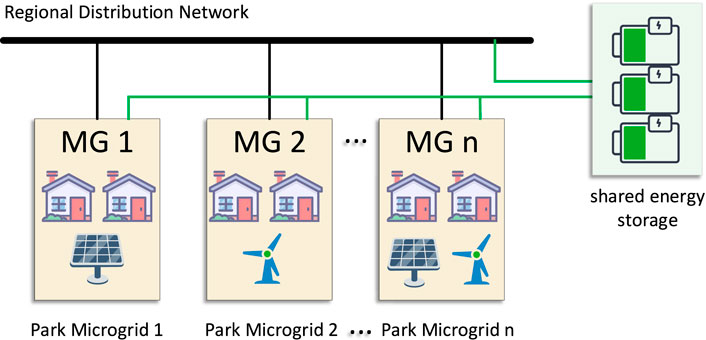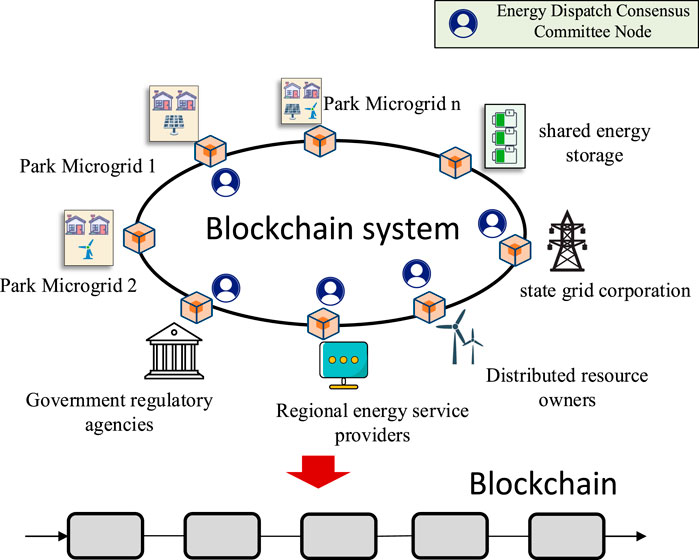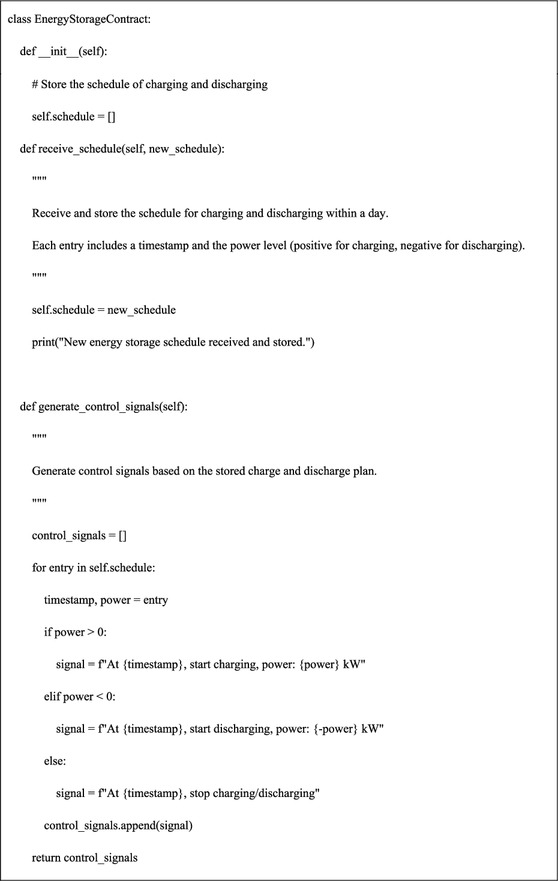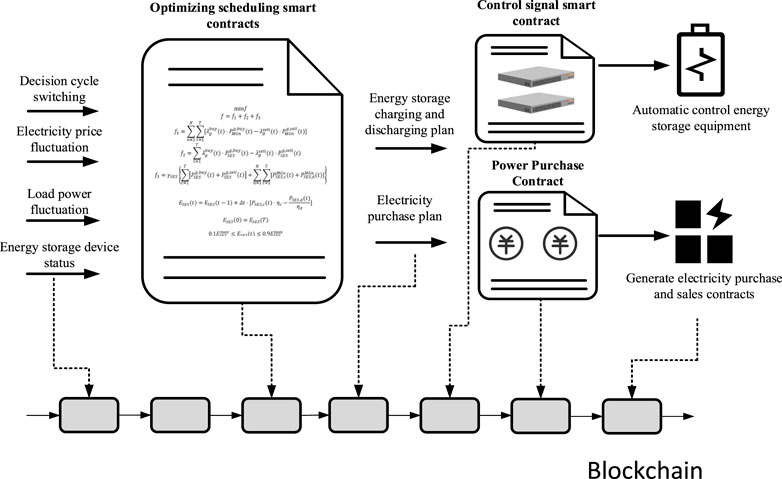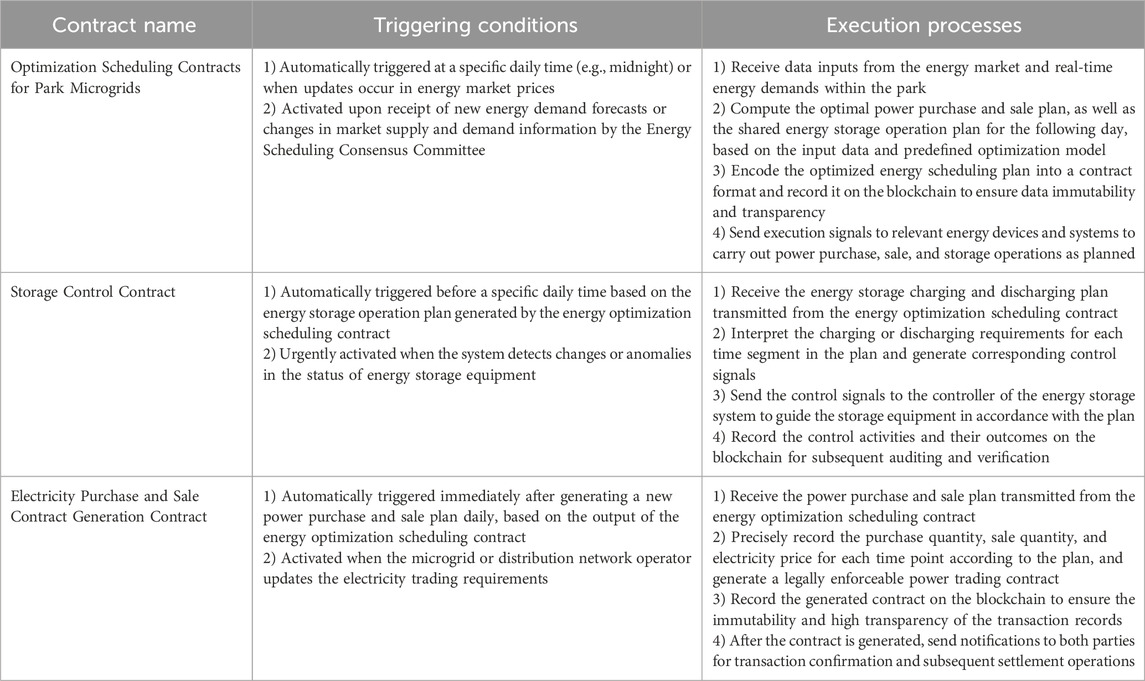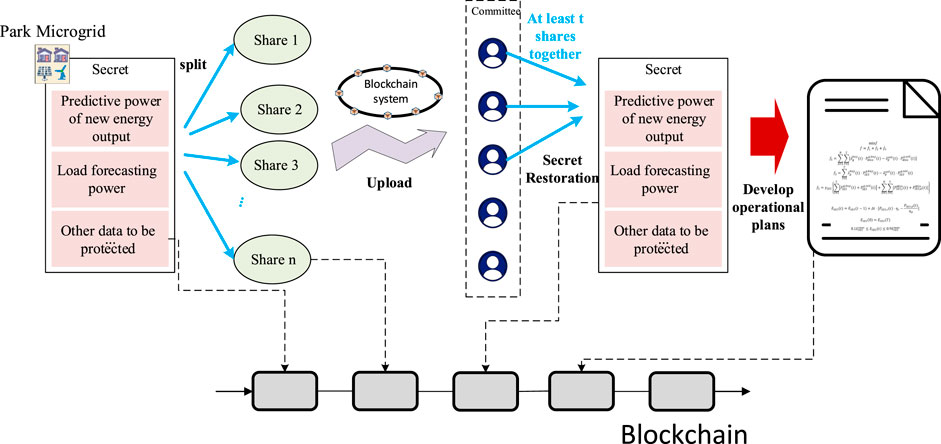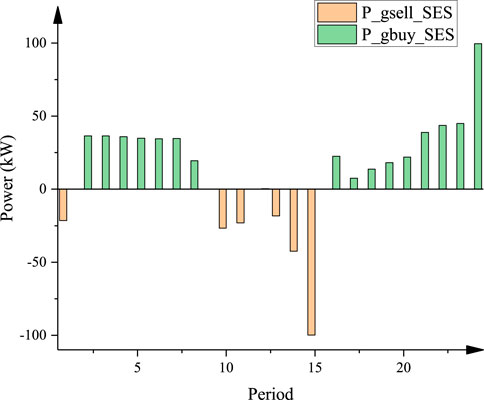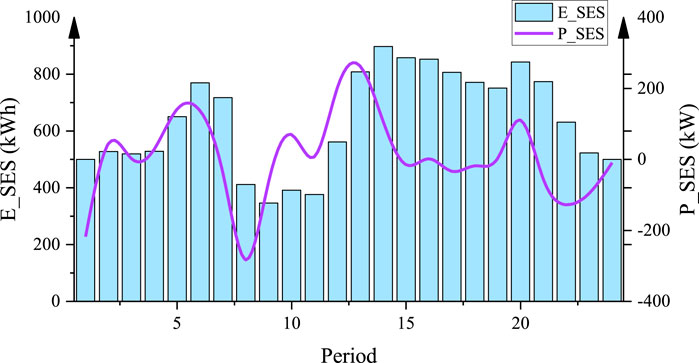- 1Shenzhen Power Supply Bureau Co., Ltd., Shenzhen, China
- 2School of Electronic Information and Electrical Engineering, Shanghai Jiao Tong University, Shanghai, China
Park microgrids, valued for their efficiency and flexibility, require privacy-conscious energy management to ensure a trusted scheduling and trading environment. This paper, focusing on park microgrids with shared energy storage, designs an energy management strategy that comprehensively considers shared energy storage, scheduling transparency, and privacy security. First, a blockchain-based energy management platform is established, forming an energy dispatch consensus committee to execute decentralized scheduling management and decision-making. Next, an optimized energy scheduling smart contract for park microgrids is designed, considering Time-of-Use (ToU) pricing and storage arbitrage to formulate the day-ahead electricity purchase and sales plans as well as the shared energy storage operation plans. Then, a privacy protection strategy based on the Shamir secret sharing scheme is proposed, effectively preventing data leakage during blockchain interactions. Finally, through case analysis, the superiority of the proposed method in microgrid optimized scheduling, data tamper-resistance, and privacy protection is demonstrated.
1 Introduction
In modern energy management, park microgrids have become a significant direction in the development of energy systems due to their efficiency, flexibility, and environmental benefits (Chaudhary et al., 2021; Singh et al., 2023). The introduction of shared energy storage technology further optimizes the energy utilization within microgrids (Zhang F. et al., 2023; Olabi 2017). Shared energy storage (SES) involves the pooling of energy storage resources, where multiple users or entities share a centralized storage system that stores excess energy during low-demand periods and releases it during peak demand, thereby balancing supply and demand across the grid. Under the ToU pricing plan, shared energy storage can store energy during off-peak periods and release it during peak periods to achieve energy arbitrage, thereby reducing energy costs. However, traditional energy management methods struggle to address complex issues such as ToU pricing, energy scheduling, and transaction transparency (Yang et al., 2021; Li et al., 2022). Blockchain technology, particularly the application of smart contracts, offers new pathways to tackle these challenges. Blockchain is a decentralized and distributed digital ledger technology that records transactions across multiple computers in a secure, immutable, and transparent manner, ensuring that each transaction is verified and added to the chain without the need for a central authority. A smart contract is a self-executing contract with the terms of the agreement directly written into code, which automatically enforces and executes the contract when predefined conditions are met, eliminating the need for intermediaries. Smart contracts can automatically execute predetermined energy management strategies, achieving efficient energy scheduling and storage management while ensuring data transparency and security. However, due to the public nature of on-chain data, users’ energy usage and transaction information may be accessed by other nodes, leading to privacy leakage risks (Yu et al., 2024; Yang et al., 2021). Therefore, it is imperative to develop an energy management strategy for park microgrids with shared energy storage under privacy protection. This strategy aims to optimize the overall operational efficiency of microgrids, reduce power costs, and promote decentralized energy scheduling management, providing innovative solutions for modern energy systems.
In recent years, researchers have conducted relevant studies on shared energy storage scheduling models and optimization methods (Li F. et al., 2019). proposed a hybrid optimization method combining Genetic Algorithm (GA) and Dynamic Programming (DP) to optimize cooling, heating, and power systems with thermal energy storage. This method improved the overall system performance by 1.92% and 1.91% in summer and winter, respectively (Chen et al., 2022); proposed a day-ahead scheduling model based on cooperative game theory to optimize the scheduling of local integrated energy systems and shared energy storage, resulting in reduced system operating costs and improved new energy consumption levels (Liu et al., 2021); proposed a user-side energy storage optimization configuration and scheduling strategy based on model predictive control, demonstrating the effectiveness of this method in peak-valley balancing and economic benefits assurance through simulations of different types of batteries (Sun et al., 2022); proposed an energy storage system scheduling strategy based on Long Short-Term Memory (LSTM) neural networks and multi-stage decision optimization, significantly improving annual revenue and system economic performance (Li et al., 2023); designed an optimal configuration method for source-grid-load-side shared energy storage systems, verifying the feasibility and effectiveness of this method through numerical examples.
The above energy management methods did not consider issues such as ToU pricing, energy scheduling, and transaction transparency. Blockchain, as a distributed shared database, allows park operators to use consensus mechanisms to jointly supervise on-chain interactive data through their respective nodes, achieving secure information sharing (van Leeuwen et al., 2020). proposed an integrated blockchain energy management platform that optimizes energy flow in microgrids through a bilateral trading mechanism. The results showed that compared to the baseline scenario, the import costs for the entire community were reduced by 34.9%, and the total import volume decreased by 15% (You et al., 2019); proposed an energy trading strategy based on smart contracts, focusing on reducing energy costs through a demand response model and verifying its effectiveness (Li Y. et al., 2019); studied methods for designing and managing distributed hybrid energy systems through smart contracts and blockchain, and verified the effectiveness of these methods through case studies in Singapore (Karthik and Anand, 2020); systematically reviebib_li_et_al_2019bwed the application of blockchain technology for energy trading in microgrids and created smart contracts using Solidity tools (Zhang T. et al., 2023); proposed a secure distributed energy trading mechanism based on smart contracts, with simulation results showing that the system is stable, scalable, and significantly reduces customer costs (Luo et al., 2021); propose a vehicle-to-vehicle (V2V) and vehicle-to-grid (V2G) electricity trading architecture based on blockchain.
Despite the transparency and immutability advantages provided by blockchain technology, the public nature of data poses a risk of privacy leakage, as users’ energy usage and transaction information may be accessed by other nodes. This necessitates additional privacy protection mechanisms to ensure data security (Wang B. et al., 2023). proposed a blockchain-based privacy data protection scheme for social networks, effectively solving privacy leakage issues in social networks using timestamp recording, hash function anonymization, asymmetric encryption, and digital signature technologies (Zhu et al., 2021); proposed a privacy data protection method based on trusted computing and blockchain, protecting on-chain and off-chain data through ECC elliptic curve encryption and AES symmetric encryption (Zhong et al., 2019); proposed a privacy-encrypted blockchain system that encrypts all data within a controllable time to protect user privacy while maintaining the immutability of the blockchain (Liang et al., 2022); proposed a personal data privacy protection scheme based on consortium blockchain, combining an improved Paillier homomorphic encryption mechanism to achieve fine-grained access control and user privacy protection (Wang P. et al., 2023). have designed a novel three-layer architecture for P2P electricity trading, whose primary objective is to protect the private information submitted to the blockchain through a new privacy-preserving trading strategy.
In summary, this paper designs an energy management strategy for park microgrids with shared energy storage, considering shared energy storage, scheduling transparency, and privacy security. First, a blockchain-based energy management platform is established, forming an energy dispatch consensus committee to execute decentralized scheduling management and decision-making. Next, an optimized energy scheduling smart contract for park microgrids is designed, considering ToU pricing and storage arbitrage to formulate the day-ahead electricity purchase and sales plans as well as the shared energy storage operation plans. Then, a privacy protection strategy based on the Shamir secret sharing scheme is proposed, effectively preventing data leakage during blockchain interactions. Finally, through case analysis, the superiority of the proposed method in microgrid optimized scheduling, data tamper-resistance, and privacy protection is demonstrated.
2 Blockchain-based energy management platform
2.1 Topological architecture of a microgrid with shared energy storage in a park
The topological architecture of the park’s microgrid is shown in Figure 1.
Each park microgrid is powered by a combination of renewable energy generation within the park and the regional power grid, implementing time-of-use electricity pricing for purchases. Renewable energy sources are prioritized for load supply, with excess electricity being sold to the regional grid. However, due to lower feed-in tariffs, this can lead to economic losses. Shared energy storage can store energy during periods of low electricity prices or surplus renewable energy production and release energy during peak price periods or when renewable energy is insufficient, thereby enabling energy arbitrage and reducing energy costs. The regional energy service provider equips each park microgrid with shared storage, alleviating the mismatch between load demand and the timing of renewable energy generation. This reduces the park microgrid’s reliance on the regional power grid and maximizes the consumption of renewable energy. The implementation of time-of-use pricing offers significant optimization opportunities for the microgrid’s electricity purchasing and storage operation plans, necessitating the development of reasonable strategies to minimize energy costs.
2.2 Blockchain platform architecture
The microgrids in each park and the regional energy service providers belong to different stakeholders, requiring a high level of trust when formulating energy management strategies. Therefore, to enhance the efficiency and transparency of energy scheduling, while ensuring data security and privacy protection during the scheduling process, this section establishes a blockchain-based energy management platform. This platform operates all park microgrids and shared storage in a decentralized manner, aiming to optimize overall economic efficiency and unify the scheduling plans for each park microgrid and shared storage.
The blockchain system provides a multi-party governance collaboration model, achieving decentralized scheduling management and decision-making through consensus verification and distributed recording without a central authority. The blockchain system includes multiple nodes, where each park microgrid, distributed resource owners, regional energy service providers, grid companies, and government regulatory agencies can participate. Energy scheduling instructions for the park microgrid and shared storage are automatically generated and executed through predefined smart contracts. These smart contracts ensure that all operations are carried out according to established rules, thereby reducing the likelihood of errors and fraud. The blockchain platform architecture established in this text is shown in Figure 2.
The core of the blockchain system is the consensus mechanism. The on-chain recording of smart contracts and other data requires validation of their legality and accuracy by consensus nodes. In this system, suitable nodes are selected from the park microgrids, distributed resource owners, regional energy service providers, grid companies, and government regulatory agencies to serve as consensus nodes, forming an Energy Scheduling Consensus Committee to ensure participation from all parties. The Energy Scheduling Consensus Committee is responsible for executing data information consensus in the blockchain system, ensuring that every scheduling instruction and transaction result is verified and recorded by the committee nodes. Each consensus node, along with other nodes, maintains a copy of the blockchain ledger, significantly enhancing data transparency and trust.
2.3 Platform Workflow
(1) Data Collection: Each electrical device collects real-time electricity consumption data through smart meters and sensors. Shared energy storage devices collect storage status data, including charge/discharge power and remaining capacity, through monitoring systems. Distributed generation devices (such as solar and wind) collect generation and equipment status data. This data is periodically uploaded to local nodes via IoT devices.
(2) Data On-Chain: Local nodes encrypt the collected key data using encryption algorithms (see Section 4) and upload it to the blockchain network. After consensus validation by the Energy Scheduling Consensus Committee, the data is broadcasted to all nodes in the blockchain system, with each node receiving and storing a copy, ensuring the reliability of distributed storage.
(3) Consensus Achievement: The Energy Scheduling Consensus Committee uses the Proof of Authority (PoA) consensus mechanism for data validation. POA is highly beneficial when applied to blockchain-based energy trading systems. PoA offers a faster and more efficient consensus mechanism compared to traditional algorithms like Proof of Work (PoW) or Proof of Stake (PoS), as it relies on a limited number of trusted validators rather than extensive computational resources or large stake holdings. This makes PoA particularly well-suited for energy trading, where transaction speed and cost-efficiency are crucial. The algorithm provides a balance between decentralization and performance, ensuring that the system remains secure and resilient while allowing for high transaction throughput. Additionally, PoA’s reliance on verified and reputable authorities aligns with regulatory and compliance requirements often found in energy markets, making it an ideal choice for implementing secure and efficient energy trading on the blockchain. Committee nodes, which have high credibility and computational power, ensure fast and accurate data validation. The committee verifies the uploaded data, confirming its legitimacy and integrity. If the data is valid, it is written into a new block through the consensus mechanism. The validated data is packaged into a block, appended with a timestamp and other necessary metadata, and then added to the blockchain. Each blockchain node updates its ledger, ensuring data consistency across all nodes.
(4) Smart Contract Execution: Based on the data on the blockchain and the predefined management strategies (see Section 3), the Energy Scheduling Consensus Committee invokes smart contracts to automatically generate and execute electricity purchase and sale plans and shared storage operation plans.
(5) Real-Time Monitoring: Participants can view energy scheduling in real-time through a blockchain explorer or customized monitoring interface. The blockchain explorer provides transparent data display, including electricity consumption, storage status, and purchase/sale records. The system includes an anomaly detection mechanism that analyzes blockchain data to promptly detect anomalies and send alerts to relevant management personnel, ensuring issues are addressed quickly.
3 Smart contract-based energy management strategy
In the energy management of campus microgrids, the introduction of smart contracts provides significant convenience for the system’s automation management. Smart contracts are self-executing programs deployed on the blockchain that can automatically execute preset energy management strategies when specific conditions are met, achieving efficient energy scheduling and storage management.
3.1 Optimization scheduling contracts for park microgrids
The Energy Scheduling Consensus Committee utilizes the optimization scheduling contracts for park microgrids discussed in this section to automatically formulate the optimal electricity purchase and sale plans, as well as shared storage operation plans. Simultaneously, the generated contracts are recorded on the blockchain, ensuring immutability and ease of verification. The core of this optimization scheduling contract is a park microgrid energy optimization scheduling model, which will be elaborated upon below.
This paper focuses on day-ahead scheduling plans, aiming to minimize the total operating costs of each microgrid and shared storage by establishing an optimization scheduling model.
3.1.1 Objective function
The objective function is defined to minimize the total operating costs of each microgrid and shared storage, as shown in the following formula.
In this formula,
3.1.2 Constraints
3.1.2.1 Power balance of each park microgrid
In this formula,
3.1.2.2 Power Interaction Balance with Shared Energy Storage
In this formula,
In this formula,
In this formula,
The constraints of this model include multiple 0-1 variables, making it a typical nonlinear optimization problem. This paper employs the Interior-Point method to solve the optimization model. The Interior-Point method is an iterative optimization technique that seeks the optimal solution by exploring the interior of the feasible region (i.e., within the constraints), thus avoiding direct searches along the boundary. This approach introduces a barrier function that incorporates the inequality constraints into the objective function, gradually approaching the constraint boundaries during the optimization process.
3.2 Storage control contract
The storage control smart contract, combined with the controller, jointly manages the charging and discharging processes of the shared energy storage. It automatically generates control signals based on the charging and discharging plans for the upcoming day. This contract receives a detailed storage charging and discharging operation plan, outlining the charging or discharging actions and their respective power levels for each period. Based on this, the smart contract calculates and sends the corresponding control signals to the storage system’s controller, achieving optimal management of the shared energy storage. Simultaneously, the generated contract is recorded on the blockchain, ensuring immutability and ease of verification. The pseudocode for this contract is shown in Table 1.
3.3 Electricity purchase and sale contract generation contract
The electricity purchase and sale contract generation contract is used to handle power transactions between the microgrid and the distribution grid, automatically generating power transaction contracts. This contract receives the microgrid’s electricity purchase and sale plans for the upcoming day. The generated contract details the purchase and sale quantities and prices at each time point, which will be used for subsequent settlement and legal enforcement. Simultaneously, the generated contract is recorded on the blockchain, ensuring immutability and ease of verification. The pseudocode for this contract is shown in Table 2.
3.4 Trigger conditions and automatic execution process of smart contracts
In the energy management of park microgrids, smart contract-based strategies enable automated energy scheduling, storage management, and the generation of electricity purchase and sale contracts. The energy optimization scheduling contract is responsible for formulating electricity purchase, sale, and storage plans based on real-time data. The storage control contract manages the charging and discharging activities of storage devices, while the electricity purchase and sale contract generation contract automatically creates legally binding transaction contracts. This automated and intelligent integrated solution not only optimizes energy usage and reduces operating costs but also enhances the system’s responsiveness to market changes. The process flowchart of the smart contract-based energy management strategy is shown in Figure 3.
The triggering conditions and automatic execution processes for each smart contract are outlined in Table 3.
4 Blockchain data privacy protection strategies
Due to the inherent transparency of blockchain, energy consumption information of microgrid users in various parks could potentially be accessed by other nodes, leading to privacy risks. This necessitates additional privacy protection mechanisms to ensure data security. Based on the architecture of the blockchain energy management platform and the Energy Scheduling Consensus Committee, a privacy protection strategy based on Shamir’s Secret Sharing Scheme has been designed. Shamir’s Secret Sharing Scheme offers significant advantages when applied to blockchain-based energy trading systems. It enhances security by dividing sensitive data, such as private keys or transaction details, into multiple shares distributed across different nodes in the network. Only a predefined number of shares are required to reconstruct the original data, making the system resilient to attacks or data breaches on individual nodes. This decentralized approach aligns well with the core principles of blockchain, ensuring that no single point of failure exists and that privacy is maintained even in a distributed environment. The scheme is particularly well-suited for energy trading, where the protection of transaction integrity and confidentiality is crucial. Its ability to prevent unauthorized access and secure sensitive information without relying on a single encryption key makes it an ideal choice for this application. The process is illustrated in Figure 4.
4.1 Encryption phase
To ensure the security and privacy of critical decision-making data (which also includes energy consumption privacy data for the microgrid), all data circulating on the blockchain is encrypted by local nodes using Shamir’s Secret Sharing Scheme before being uploaded to the blockchain. This process divides the data into multiple parts. The encrypted data is then transmitted through the blockchain network to each member node of the Energy Scheduling Consensus Committee, where each node receives and stores a copy of the data. The specific steps are as follows:
(1) Choose a finite field
(2) Select
(3) The data provider randomly selects a polynomial
(4) Compute
4.2 Decryption phase
To decrypt the key data used for scheduling plans, at least t consensus nodes in the Energy Scheduling Consensus Committee must collaborate to reconstruct the secret from their respective shares. This multi-node decryption process not only enhances data processing transparency but also prevents any single node from generating inaccurate scheduling plans through mutual supervision, thus ensuring the correctness and fairness of the scheduling results. The specific steps are as follows:
(1) Any t secret holders submit their secret values
(2) Setting x = 0 yields the secret
5 Example analysis
5.1 Initial data presentation
This study involves the joint operation energy management of three park microgrids and one shared energy storage system. The configurations are as follows: Park Microgrid 1 is equipped with a photovoltaic power generation unit with a capacity of 750 kW. Park Microgrid 2 is equipped with a wind power generation unit with a capacity of 1,000 kW. Park Microgrid 3 is equipped with both 600 kW of photovoltaic power and 500 kW of wind power. The shared energy storage system has a configuration capacity of 400 kW and 1,000 kWh.
The wind and solar power forecasts for each park microgrid are illustrated in Figures 5A–C, and the load forecast power and time-of-use electricity price data are shown in Figures 5E, F.
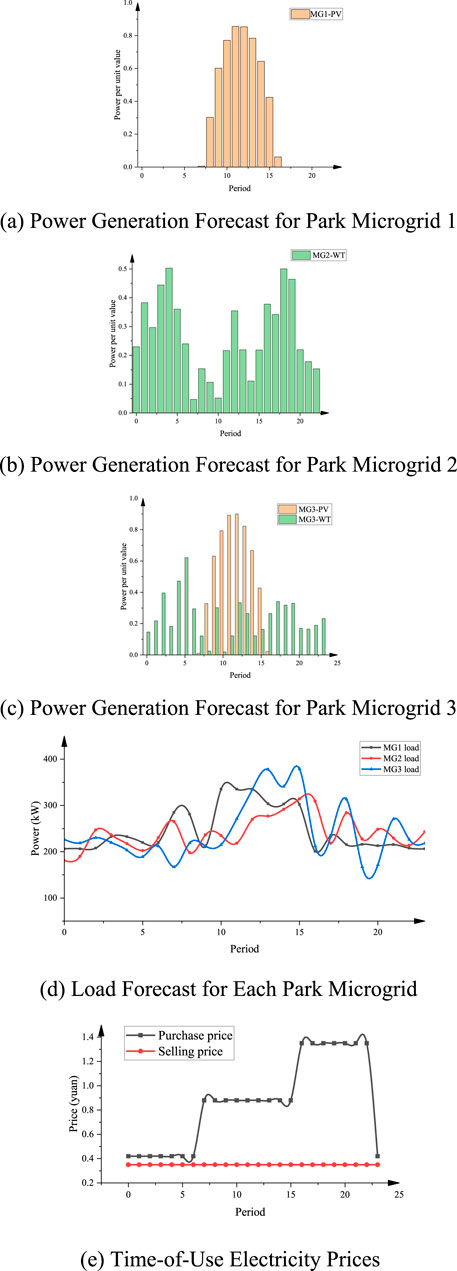
Figure 5. Initial data presentation chart. (A) Power Generation Forecast for Park Microgrid 1 (B) Power Generation Forecast for Park Microgrid 2 (C) Power Generation Forecast for Park Microgrid 3 (D) Load Forecast for Each Park Microgrid (E) Time-of-Use Electricity Prices.
5.2 Optimization scheduling results presentation
This section presents simulation tests of the privacy-protected energy management strategy for shared energy storage microgrids based on smart contracts in a laboratory environment. The laboratory setup includes a host with an Intel (R) Core i7-10700F CPU @ 2.90 GHz, 16 GB RAM, and Windows 11 operating system. The optimization scheduling is performed using MATLAB 2020a for algorithm design and simulation testing. A blockchain-based energy management platform is built on the Ethereum platform and developed using Solidity. Smart contracts are deployed and tested through the Ganache local simulator, with management facilitated by the Truffle framework. The Shamir Secret Sharing Scheme portion is implemented using Python 3.10 for algorithm design and simulation testing.
The optimized power purchase and sale plans for each park microgrid are illustrated in Figure 6.
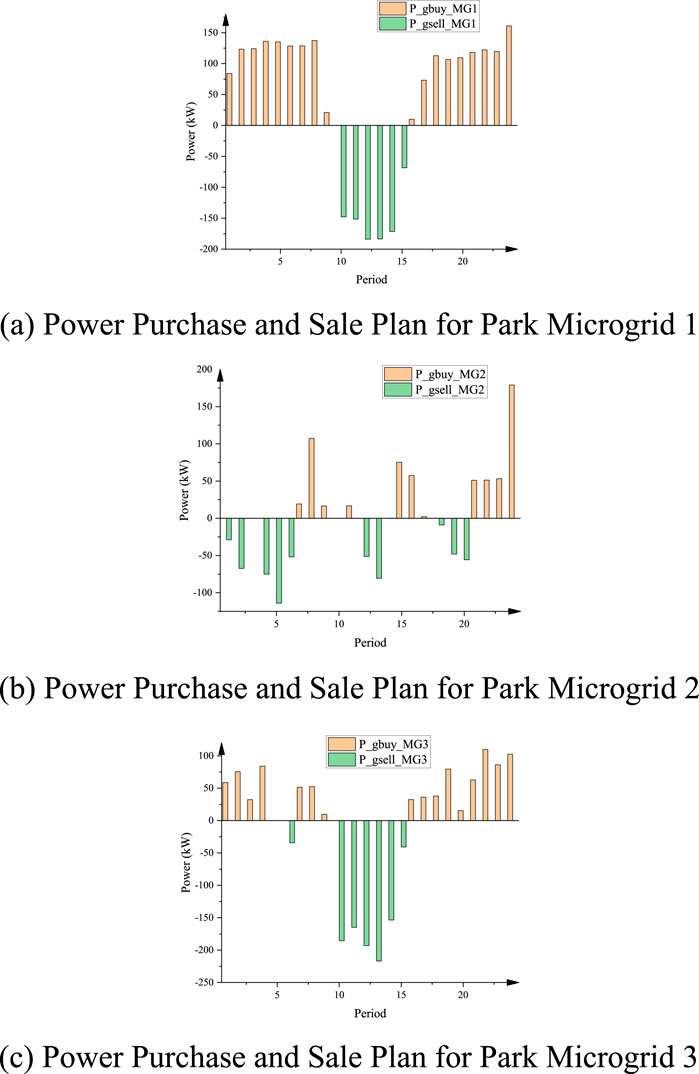
Figure 6. Optimization results of microgrid power purchase and sale plans. (A) Power Purchase and Sale Plan for Park Microgrid 1 (B) Power Purchase and Sale Plan for Park Microgrid 2 (C) Power Purchase and Sale Plan for Park Microgrid 3.
The optimized charging and discharging operation plans for each park microgrid and the shared energy storage are illustrated in Figure 7.
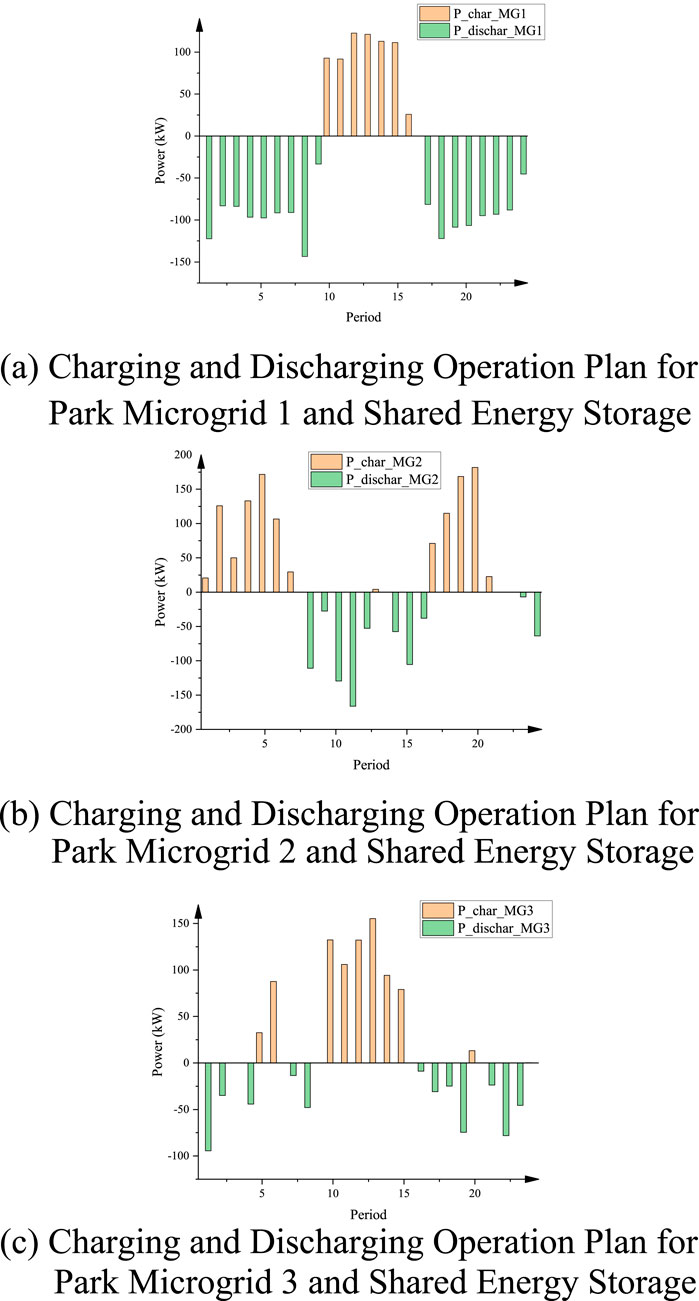
Figure 7. Optimization of charging and discharging operation plan for microgrids and shared energy storage. (A) Charging and Discharging Operation Plan for Park Microgrid 1 and Shared Energy Storage (B) Charging and Discharging Operation Plan for Park Microgrid 2 and Shared Energy Storage (C) Charging and Discharging Operation Plan for Park Microgrid 3 and Shared Energy Storage.
The optimized power purchase and sale plan for the shared energy storage and the distribution network is illustrated in Figure 8.
The Figure 9 illustrates the changes in the total charging and discharging power of the shared energy storage and its capacity after optimization.
5.3 Economic cost analysis
Shared energy storage can store energy during off-peak periods and release it during peak periods to achieve energy arbitrage, thereby reducing energy costs. This section sets up five scenarios to compare and analyse the economic costs under different energy storage capacity configurations. The details are shown in Table 4.
This section covers five scenarios ranging from no storage to high storage capacities. The total operating costs are as follows: Without storage, the total operating cost is CNY 4713. With 300 kW power and 800 kWh capacity storage, the total operating cost decreases to CNY 3261. With 400 kW power and 1,000 kWh capacity storage, the total operating cost further decreases to CNY 3124. With 800 kW power and 2000 kWh capacity storage, the total operating cost significantly drops to CNY 1333. Scenario 5, which represents an extreme case with 1,000 kW power and 20,000 kWh capacity storage, results in the lowest total operating cost of CNY 710.
The results indicate that as storage capacity increases, the total operating cost of the system decreases significantly. Particularly in the extreme Scenario 5, the substantial increase in storage capacity results in the most significant energy arbitrage effect, reducing operating costs by approximately 85%. This highlights the importance of introducing and increasing the capacity of storage systems for lowering energy costs, especially during periods of high price disparity between peak and off-peak times.It should be noted that this study focuses on energy automation scheduling management based on smart contracts, optimizing solely for operating costs without considering the initial cost of storage configuration. While increased storage capacity significantly lowers operating costs, the configuration cost of the storage system typically rises with capacity. Although Scenario 5 shows the lowest operating cost, a high initial investment for a 1,000 kW power and 20,000 kWh capacity storage system may render such a configuration economically unfeasible.
In summary, configuring shared storage for park microgrids can optimize grid operation efficiency and enhance the grid’s adaptability to demand fluctuations, leading to more economical and environmentally friendly energy management.
5.4 Privacy protection performance analysis
The Figure 10 below demonstrates the encryption and decryption effects of the proposed algorithm. Using the load forecast power of Park Microgrid 1 as an example, the forecasted power for 24 points of the previous day is encrypted and sent to five Energy Scheduling Consensus Committee members. The received load power curves for the five members, represented by s1, s2 … , s5 in Figure 10, show that the encrypted power data is random and significantly different from the actual power values. During the decryption phase, any three members combine their respective secret shares to complete the decryption. The curves in Figure 10 illustrate that the decryption algorithm accurately recovers the actual power values. This demonstrates the feasibility and effectiveness of the privacy protection algorithm proposed in this study.
6 Summary and future outlook
This study establishes a blockchain-based energy management platform for park microgrids with shared energy storage. It sets up a decentralized scheduling management and decision-making mechanism based on an Energy Scheduling Consensus Committee. It designs an energy management strategy for park microgrids based on smart contracts, automating the generation and execution of power purchase and sale plans as well as energy storage operation plans. It also proposes a privacy protection strategy based on Shamir’s Secret Sharing Scheme, effectively preventing data leakage during blockchain information exchanges. Through case analysis, the superiority of the proposed methods in optimizing microgrid scheduling, data tamper-proofing, and privacy protection is demonstrated.
This research provides significant value by addressing the critical challenges of privacy protection and transparent energy management in park microgrids. By integrating blockchain technology and smart contracts, it enhances the security and integrity of energy transactions, fostering trust among multiple stakeholders. Additionally, the proposed privacy protection mechanisms safeguard sensitive information, ensuring that energy management processes are both secure and efficient. These contributions are crucial for advancing decentralized energy management practices and promoting the adoption of smart grid technologies in the future.
As blockchain technology continues to mature and the functions of smart contracts expand, designing more efficient, cost-effective, and secure energy trading mechanisms will be a key research focus. Balancing technological development with environmental protection, economic costs with social responsibilities, will also be a comprehensive issue that must be considered for the development of microgrids. Therefore, future research could further deepen and explore these aspects.
Data availability statement
The original contributions presented in the study are included in the article/supplementary material, further inquiries can be directed to the corresponding author.
Author contributions
WL: Conceptualization, Data curation, Formal Analysis, Investigation, Methodology, Writing–original draft, Writing–review and editing. QA: Methodology, Supervision, Visualization, Writing–review and editing.
Funding
The author(s) declare that financial support was received for the research, authorship, and/or publication of this article. This research was funded by the project “Research and Application of Regional-scale User-side Resource Coordination and Interaction Technology” (No. 090000KC22120002).
Conflict of interest
Author WL was employed by Shenzhen Power Supply Bureau Co., Ltd.
The remaining author declares that the research was conducted in the absence of any commercial or financial relationships that could be construed as a potential conflict of interest.
Publisher’s note
All claims expressed in this article are solely those of the authors and do not necessarily represent those of their affiliated organizations, or those of the publisher, the editors and the reviewers. Any product that may be evaluated in this article, or claim that may be made by its manufacturer, is not guaranteed or endorsed by the publisher.
References
Chaudhary, G., Lamb, J. J., Burheim, O. S., and Austbø, B. (2021). Review of energy storage and energy management system control strategies in microgrids. Energies 14 (16), 4929. doi:10.3390/en14164929
Chen, C., Li, Y., Qiu, W., Liu, C., Zhang, Q., Li, Z., et al. (2022). Cooperative-game-based day-ahead scheduling of local integrated energy systems with shared energy storage. IEEE Trans. Sustain. Energy 13 (4), 1994–2011. doi:10.1109/tste.2022.3176613
Karthik, P. K., and Anand, R. (2020). “Energy trading in microgrids using blockchain technology,” in 2020 4th international conference on intelligent computing and control systems (ICICCS). IEEE, 884–888. doi:10.1109/iciccs48265.2020.9121050
Li, B., Yang, F., Qi, B., Bai, X., Sun, Y., and Chen, S. (2022). Research on key technologies of P2P transaction in virtual power plant based on blockchain. IET Smart Grid 5, 223–233. doi:10.1049/stg2.12064
Li, C., Liu, Y., Zhang, T., Zhao, Z., Liu, H., Zhu, X., et al. (2023). Optimization method of shared energy storage configuration on source-grid-load side of power system. doi:10.1109/powercon58120.2023.10331018
Li, F., Sun, B., Zhang, C., and Liu, C. (2019a). A hybrid optimization-based scheduling strategy for combined cooling, heating, and power system with thermal energy storage. Energy 188, 115948. doi:10.1016/j.energy.2019.115948
Li, Y., Yang, W., He, P., Chen, C., and Wang, X. (2019b). Design and management of a distributed hybrid energy system through smart contract and blockchain. Appl. Energy 248, 390–405. doi:10.1016/j.apenergy.2019.04.132
Liang, W., Yang, Y., Yang, C., Hu, Y., Xie, S., Li, K.-C., et al. (2022). PDPChain: a consortium blockchain-based privacy protection scheme for personal data. IEEE Trans. Reliab. 72, 586–598. doi:10.1109/TR.2022.3190932
Liu, Y., Liu, Q., Guan, H., Li, X., Bi, D., Guo, Y., et al. (2021). Optimization strategy of configuration and scheduling for user-side energy storage. Electronics 11 (1), 120. doi:10.3390/electronics11010120
Luo, L., Feng, J., Yu, H., and Sun, G. (2021). Blockchain-enabled two-way auction mechanism for electricity trading in internet of electric vehicles. IEEE Internet Things J. 9, 8105–8118. doi:10.1109/jiot.2021.3082769
Olabi, A. G. (2017). Renewable energy and energy storage systems. Energy 136, 1–6. doi:10.1016/j.energy.2017.07.054
Singh, A. R., Koteswara Raju, D., Phani Raghav, L., and Seshu Kumar, R. (2023). State-of-the-art review on energy management and control of networked microgrids. Sustain. energy Technol. assessments 57, 103248. doi:10.1016/j.seta.2023.103248
Sun, T., Zhao, J., Liu, L., Ma, L., Zhang, P., et al. (2022). “Optimal scheduling of renewable energy power station with energy storage system based on Long short-term memory electricity price forecasting,” in 2022 5th international conference on power and energy applications (ICPEA). IEEE, 510–514.
van Leeuwen, G., AlSkaif, T., Gibescu, M., and van Sark, W. (2020). An integrated blockchain-based energy management platform with bilateral trading for microgrid communities. Appl. Energy 263, 114613. doi:10.1016/j.apenergy.2020.114613
Wang, B., Xu, L., and Wang, J. (2023b). A privacy-preserving trading strategy for blockchain-based P2P electricity transactions. Appl. Energy 335, 120664. doi:10.1016/j.apenergy.2023.120664
Wang, P., Zhu, J., and Ma, Q. (2023a). Private data protection in social networks based on blockchain. Int. J. Adv. Netw. Appl. 14 (04), 5549–5555. doi:10.35444/ijana.2023.14407
Yang, Q., Wang, H., Wang, T., Zhang, S., Wu, X., and Wang, H. (2021). Blockchain-based decentralized energy management platform for residential distributed energy resources in a virtual power plant. Appl. Energy 294, 117026. doi:10.1016/j.apenergy.2021.117026
You, H., Hua, H., and Cao, J. (2019). “A smart contract-based energy trading strategy in energy internet,” in 2019 IEEE international conference on energy internet (ICEI). IEEE, 478–483. doi:10.1109/icei.2019.00090
Yu, S., Wei, Z., Sun, G., Zhou, Y., and Zang, H. (2024). A double auction mechanism for virtual power plants based on blockchain sharding consensus and privacy preservation. J. Clean. Prod. 436, 140285. doi:10.1016/j.jclepro.2023.140285
Zhang, F., Li, D., Zhang, Y., and Chen, B. (2023a). “A secure distributed energy trading mechanism for residential communities based on smart contract,” in 2023 8th asia conference on power and electrical engineering (ACPEE). IEEE, 970–975. doi:10.1109/acpee56931.2023.10135882
Zhang, T., Qiu, W., Zhang, Z., Lin, Z., Ding, Y., Wang, Y., et al. (2023b). Optimal bidding strategy and profit allocation method for shared energy storage-assisted VPP in joint energy and regulation markets. Appl. Energy 329, 120158. doi:10.1016/j.apenergy.2022.120158
Zhong, P., Zhong, Q., Mi, H., Zhang, S., and Xiang, Y. (2019). Privacy-protected blockchain system 2019 20th IEEE international conference on mobile data management (MDM). doi:10.1109/mdm.2019.000-2
Keywords: shared energy storage, microgrid, energy management, optimal dispatch, smart contracts, blockchain, privacy protection
Citation: Liu W and Ai Q (2024) Design of energy management strategies for shared energy storage microgrid based on smart contracts under privacy protection. Front. Energy Res. 12:1476620. doi: 10.3389/fenrg.2024.1476620
Received: 06 August 2024; Accepted: 30 August 2024;
Published: 25 September 2024.
Edited by:
Yuanxing Xia, Hohai University, ChinaReviewed by:
Junjie Hu, North China Electric Power University, ChinaTianguang Lu, Shandong University, China
Copyright © 2024 Liu and Ai. This is an open-access article distributed under the terms of the Creative Commons Attribution License (CC BY). The use, distribution or reproduction in other forums is permitted, provided the original author(s) and the copyright owner(s) are credited and that the original publication in this journal is cited, in accordance with accepted academic practice. No use, distribution or reproduction is permitted which does not comply with these terms.
*Correspondence: Qian Ai, YWlxaWFuQHNqdHUuZWR1LmNu
 Wentao Liu1
Wentao Liu1 Qian Ai
Qian Ai